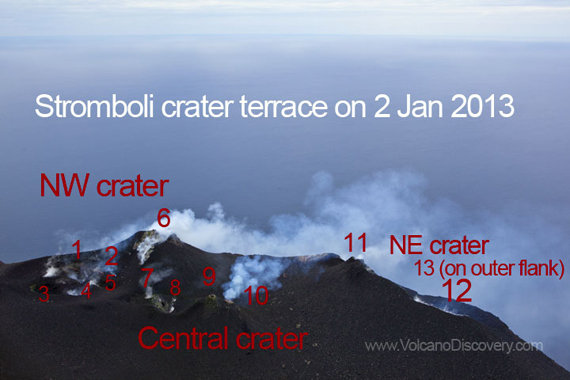Every 15-50 minutes, large lava bubbles exploded with loud detonations and ejected bright, liquid lava into all directions and reached heights of up to estimated 4-500 meters.
 |
| Exploding lava bubble from the NE vent (12). |
We visited Stromboli on 2 January and observed the following activity from about 8 vents in total (see image for location and naming of vents): The western crater produced tall, very noisy, straight candle-like strombolian fountains up to 300 m tall every 10-20 minutes from vent 2, lasting 5-20 seconds, often accompanied by ash-rich ejections from vent 1.
 |
| Simultaneous spatter- and ash-rich eruptions from the NW vent (1 and 2). |
The large hornito (6) at the northern crater rim was constantly glowing and spattering, and sometimes had small strombolian eruptions as well. The central crater activity was dominated by continuous spattering from a glowing circular vent (10) that ejected pulsating puffs of hot gas and steam and sometimes produced small gas rings that remained visible for up to 2 minutes. The by far largest activity occurred from the main vent (12) of the spatter cone that has been built around the eastern crater area over the past few years. Every 15-50 minutes, large lava bubbles exploded with loud detonations and ejected bright, liquid lava into all directions and reached heights of up to estimated 4-500 meters.
 |
| The configuration of the crater terrace on 3 Jan 2013. |
Bright glow and often continuous spattering from inside it indicated that its magma column was high, and on one occasion, the start of a small overflow through its gap could be seen (but this process was then interrupted by an explosion). The hornito-shaped vent 11 to the west of the main crater 12 was also constantly glowing and spattering and sometimes produced candle-like strombolian jets to heights of up to about 100 m. A small lateral effusive vent (13) of the SE crater was observed on the northern outer slope of the cone, about 20 meters below the rim, visible from the east and south-east and from the 400m viewpoint. Mostly, it was a barely glowing spot, but occasionally, it effused some glowing lava blocks that started to roll down the slope. This must have been the vent which had produced the small lava flows sometimes visible on webcam images during the last days of December. A series of photos will be published in the near future.
source
SILENT OBSERVER:
No comments:
Post a Comment